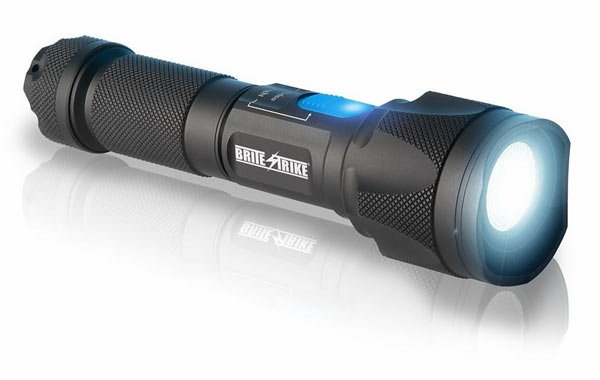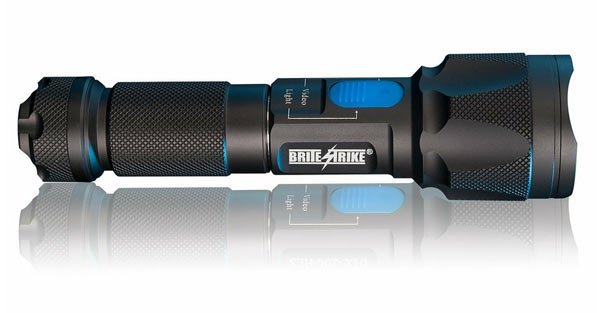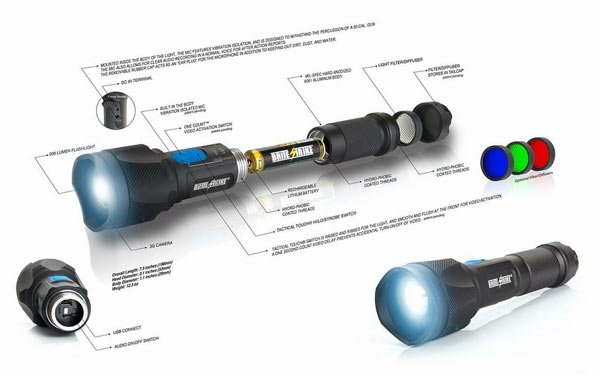Brite-Strike is now making a flashlight camera for duty use. The “Duty Light Camera” (aka DLC-200-4-MIL-RC) is a handheld LED flashlight that can record standard definition video in addition to throwing up to 200 lumens of light.
The flashlight is relatively small at 7.5″ long. This puts it into the same general size category as the Streamlight Stinger flashlight (7.4″ long). The Brite-Strike weighs about 12.3 ounces. By comparison, it is slightly heavier than the 10 ounces of the Stinger.

The Duty Light Camera has three flashlight modes: high, low and strobe. High mode puts out 200 lumens, while the low output mode gives 80 lumens. I could not find any peak beam candella measurements for this flashlight, which would give you a better sense of the brightness of the center portion of the light instead of just the total output.
The light control switch is located on the body of the light, near the flashlight camera head. There is not a tailcap switch.
“Rechargeable, this flashlight is,” said Yoda. A rechargeable lithium battery is included along with a 120 volt and 12 volt charger (for both home and the “office”). Run time for the flashlight on “high” is about 2.5 hours. I’m not sure how long a single charge will run the light and the video recorder.
Replacement lithium batteries can be purchased from Brite-Strike. They run $40 each and have a rating of 2400 mAh.
The 640×480 resolution offered by the Duty Light Camera bests old analog TV signals but falls well short of standard HD broadcast television. It is better than the old VCR recordings if you need a still image to print, but it still doesn’t give you much to work with.
Typical point-and-shoot consumer cameras offer at least 1280×720 resolutions, while many go to 1920×1080. Both of the larger formats give the viewer a much clearer image, and allows for better enhancement of shadows and other details when needed by investigators.

To Brite-Strike’s credit, the sample videos they provide on their website are very clear and crisp when compared to other videos I have seen at the same resolution. The camera uses a CMOS sensor. The light seems to be well aligned with the camera, and everything the flashlight’s beam hits is well lit in the recording.
The flashlight camera video recorder uses a 3GP container typically seen in cell phone cameras. The format is easily exported to computers and can be converted to other formats such as .avi and .mp4. I am not an expert on video formats and multi-media containers, but it is my understanding that the 3GP container is essentially a compressed mp4 allowing for smaller file sizes.
The Duty Light Camera has a built in 4 GB memory, which is said to hold up to six hours of video. I think that figure may be very optimistic, but even at half of the stated figure, three hours of recording time is fairly impressive. A USB cable is included to download the video. The site does not state USB 3, so I expect it is a slower USB 2 interface and cable.
The audio mic is covered by a rubber plug to keep out dust, dirt and water. The flip side to that is you have to remember to unplug the cap to record audio. If you are using the video to record an incident, and the cap isn’t open, you will get video but no audio.
You can manually shut off the audio recorder if required to do so by policy or law. Unscrew the forward portion of the light (which includes the flashlight head and control switch) and on the inside of the body you will be able to access the on/off switch for the mic. This is also where the USB post is located.
MSRP on the Brite-Strike flashlight camera is $500. Throw in the “Roto-Loc” holster designed for the Duty Light Camera and you add $60 to the bottom line. Yes, those are MSRP – As of this writing, Amazon has the Duty Light Camera for $373.98 and the Roto-Loc for $31.59.
It seems like all new police gadgets coming out have a video recorder built in. Even our pistols and Tasers can be outfitted with video cameras now. Video is a double-edged sword as it can show what happened on a scene – but typically at a low resolution, with adequate to poor audio recording and almost never from the officer’s actual point of view. In most situations this is fine, but with an ever increasing attack on law enforcement by the radical anarchists in society, it becomes more important than ever to improve the video recording devices we use.
While most of us might think of using this flashlight to record interviews and use of force encounters, I think the video function might be best suited to conducting consent and warrant searches. With the camera running you can document exactly what you find, in what location and when you found it. It seems to be a more elegant solution than trying to run a camcorder in one hand while working with a flashlight in another.
Based on the specs and sample videos provided, the Brite-Strike DLC-200-4-MIL-RC looks like it will do a good job. However, I would prefer to see an HD version with the ability to use a micro-SD card for expansion to 32 GB of recording space. I understand there are technical limitations when dealing with miniature products, but hey…a guy can dream can’t he?
